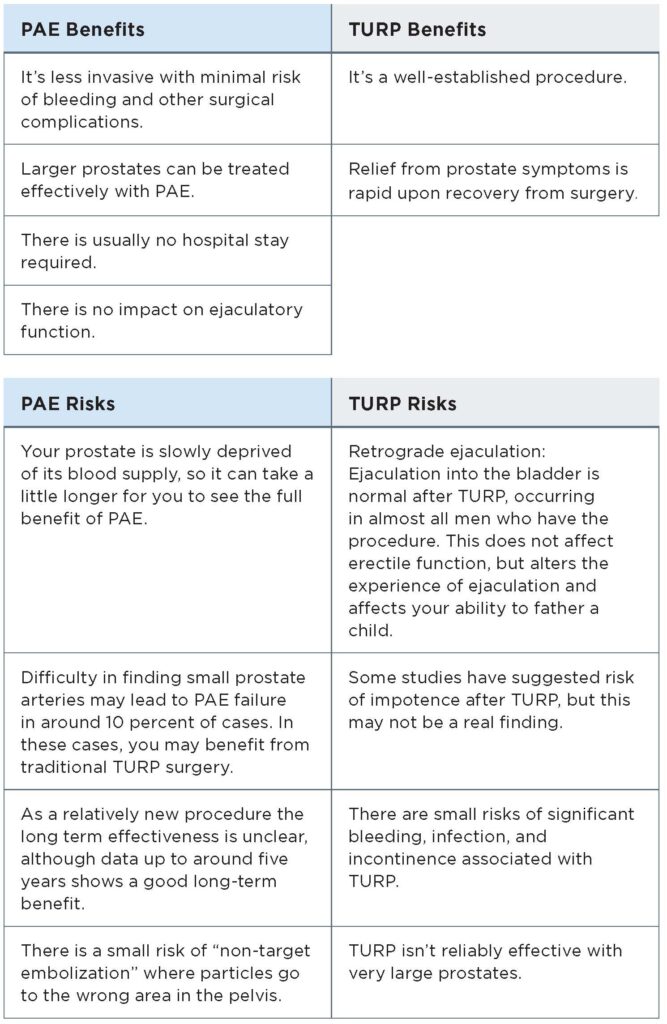
Home PROSTATE SURGERY: IS THERE AN ALTERNATIVE TO TURP?
As men age, their prostate grows; it’s a fact of life. It’s usually not a serious problem, but over 30 percent of men aged 50 and over require treatment for an enlarged prostate and for some of them that means surgery.
The prostate gland sits underneath the bladder and surrounds part of the urethra, the tube that carries urine and semen out of your penis. Normally, it’s the size and shape of a walnut, but as men age it can sometimes get too big and start to squeeze the urethra. This is called benign prostatic hyperplasia (BPH). It can disturb sleep with frequent urination overnight, or cause a hard time urinating or a weak stream when you do start.
BPH is not prostate cancer, nor does it make you more likely to get it. It’s a common condition with a number of treatment options, ranging from lifestyle changes to medication to surgery. Your health care practitioner can help you determine the best option for you based on your age, health, and current symptoms.
In cases of surgery, the most commonly performed procedure is a transurethral resection of the prostate (TURP). Very large prostates are not effectively treated with TURP, so an open surgery is usually performed to completely or partially remove the enlarged prostate. These are not the only options however. Mayfair Diagnostics radiologists have been successfully performing prostate artery embolization (PAE) procedures as an alternative to surgery in Calgary hospitals since 2012.
First performed in 2009 by Professor Pisco in Portugal, this new procedure shrinks an enlarged prostate by non-surgically blocking the arteries that feed the gland. An interventional radiologist, rather than a surgeon, performs the procedure through a pinhole in the groin.
The interventional radiologist will use X-ray guidance to move a small plastic tube into the small arteries which are feeding the prostate. A special X-ray dye is injected down the catheter to identify the prostate blood supply. Then fluid containing thousands of tiny plastic particles is injected into these small arteries to block them and starve the prostate of its blood supply.
PAE is done using a local anesthetic in the groin and intravenous painkillers and/or sedatives, if needed. A catheter is inserted into the bladder for a few hours during the procedure.
During a TURP, an instrument is inserted into the tip of your penis and extended through your urethra into the prostate area. Your doctor will then use it to trim tissue from the inside of your prostate gland, one small piece at a time, to remove the section of the prostate that is blocking urine flow. As small pieces of tissue are removed, irrigating fluid carries them into your bladder.
TURP is done using a general or spinal anesthetic and a catheter will be inserted into your bladder. It usually requires a one- or two-day stay in the hospital and the catheter is generally left in place for at least 24 to 48 hours, until the bleeding subsides.

PAE procedures are covered under the Alberta Health Care Insurance Plan. Your doctor or specialist will need to fax a consultation request to Rockyview General Hospital’s Diagnostic Imaging department at 403-592-4852. Once the information has been received our interventional radiology team will review the request and contact you to arrange a consultation to determine if the procedure is appropriate based on your medical history. There may also be imaging required.
REFERENCES
Abt, D., et al. (2018) “Comparison of prostatic artery embolisation (PAE) versus transurethral resection of the prostate (TURP) for benign prostatic hyperplasia: randomised, open label, non-inferiority trial.” BMJ 2018; 361:k2338.
Gao, Y., et al. (2014) “Benign Prostatic Hyperplasia: Prostatic Arterial Embolization versus Transurethral Resection of the Prostate—A Prospective, Randomized, and Controlled Clinical Trial.” Radiology, Mar; 270 (3): 920-28.
Johns Hopkins Medicine (2022) “Prostatic Artery Embolization.” www.hopkinsmedicine.org. Accessed September 1, 2022.
Mayo Clinic Staff (2022) “Transurethral resection of the prostate (TURP).” www.mayoclinic.org. Accessed September 1, 2022.
Healthwise Staff (2021) “Transurethral Resection of the Prostate (TURP) for Benign Prostatic Hyperplasia.” www.myhealthalberta.ca. Accessed September 1, 2022.
Nickel, J.C., et al. (2018) “Canadian Urological Association guideline on male lower urinary tract symptoms/benign prostatic hyperplasia (MLUTS/BPH): 2018 update.” Canadian Urological Association Journal, Oct. 4(5): 310-16.
Urology Care Foundation (2021) “What is Benign Prostatic Hyperplasia (BPH)?” www.urologyhealth.org. Accessed September 1, 2022.
© 2024 Mayfair. All rights reserved.
| Cookie | Duration | Description |
|---|---|---|
| cookielawinfo-checkbox-analytics | 11 months | This cookie is set by GDPR Cookie Consent plugin. The cookie is used to store the user consent for the cookies in the category "Analytics". |
| cookielawinfo-checkbox-functional | 11 months | The cookie is set by GDPR cookie consent to record the user consent for the cookies in the category "Functional". |
| cookielawinfo-checkbox-necessary | 11 months | This cookie is set by GDPR Cookie Consent plugin. The cookies is used to store the user consent for the cookies in the category "Necessary". |
| cookielawinfo-checkbox-others | 11 months | This cookie is set by GDPR Cookie Consent plugin. The cookie is used to store the user consent for the cookies in the category "Other. |
| cookielawinfo-checkbox-performance | 11 months | This cookie is set by GDPR Cookie Consent plugin. The cookie is used to store the user consent for the cookies in the category "Performance". |
| viewed_cookie_policy | 11 months | The cookie is set by the GDPR Cookie Consent plugin and is used to store whether or not user has consented to the use of cookies. It does not store any personal data. |